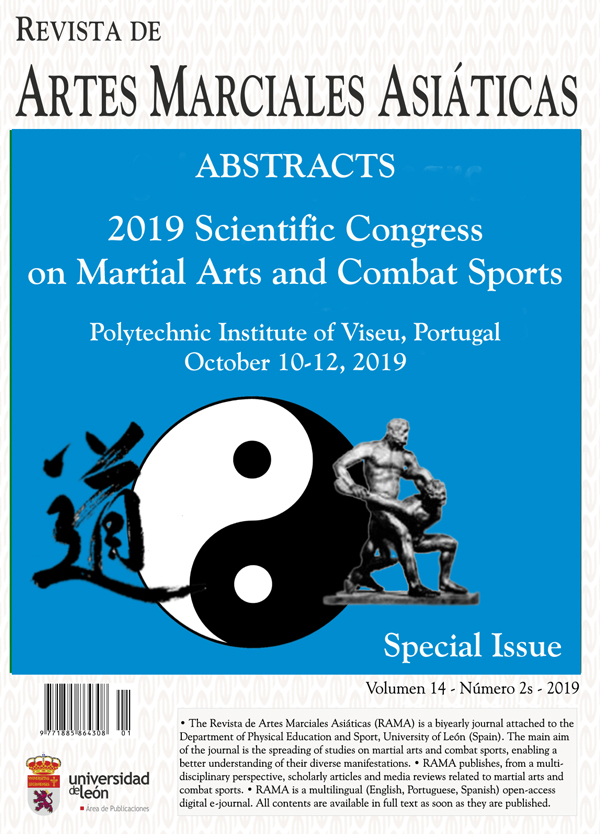The gist and significance of wrist work in the old Polish fencing sabre based on selected techniques of cuts and thrusts
DOI:
https://doi.org/10.18002/rama.v14i2s.5961Palavras-chave:
Martial arts, wrist movements, carpal bones, old Polish fencing, hussar sabre, short stick fightingResumo
The aim of this study was to determine the essence and importance of wrist movements for the old Polish sabre fencing. Analysis of available writings, work with old Polish fencing students in the years 2009 – 2019, empirical interpretation of the described techniques. The analysis of available writings, the work with old Polish fencing students in the years 2009 – 2019, and empirical interpretation of the described techniques were used. Results showed that wrist work was essential for the execution of a number of historical techniques. It allowed to gain control over the opponent’s blade and prevail in the clash. Further research on old Polish fencing is necessary.
Downloads
Métricas alternativas
Referências
Bochenek A., & Reicher, M. (1968). Anatomia człowieka T.I, s. 433. Warszawa: PZWL.
Borysiuk, Z. (2005). The historical transformation of sabre fencing. Ido – Ruch dla Kultury / Movement for Culture, 5, 9-15.
Cynarski, W. (2004) About the art of fencing. Remarks on classical fencing. Ido – Ruch dla Kultury / Movement for Culture, 4, 29-44,
Czajkowski, Z. (2007). Fencing in ancient Poland. Ido – Ruch dla Kultury / Movement for Culture, 7, 55-64.
Ivanovsky, M. (1834). Nouveau Systéme d’Escrime pour la cavalerie, fondé sur l’emploi d’un nouveau sabre inventé par M. Ivanowski, officier polonais. Paris: Poussielgue
John, A., & Musiolik, A. (2010) Analiza kinematyczna palców ręki. Retrieved from http://www.kms.polsl.pl/mi/pelne_9/15.pdf
Łaski, S. (1599). Spraw i postępków rycerskich i przewagi opisanie krótkie, opus post mortem. Lviw, Poland
Maroteaux, R., J. (2011). Special sabre polonais & japonais. Aiki Goshin Do Kaishi, (55), 12-22.
Maroteaux, R., J. (2019). Special sabre polonais. Aiki Goshin Do Kaishi, (77), 23-27.
Marsden, R. (2015). Polish Saber. The use of the Polish Saber on foot in the 17th century. Cambridge: Tyrant Industries.
Miklaszewski J. (n.d.). Polish Historical Fencing. Retrieved from https://www.youtube.com/watch?v=ANPrQ4N4HNw
Sawicki, Z. (2014). Influence of the Polish martial art onto European armies in the 18th and 19th centuries. Ido Movement for Culture. Journal of Martial Arts Anthtopology, 14(4), 3-13. doi: https://doi.org/10.14589/ido.14.4.2
Sawicki, Z. (2008). Michała Starzewskiego traktat „O szermierstwie” w interpretacji Zbigniewa Sawickiego. Zawiercie: Wydawnictwo Signum Polonicum.
Sawicki, Z. (2005). Palcaty. Podręcznik dla początkujących. Zawiercie: Wydawnictwo Signum Polonicum.
Sawicki, Z. (2019). Palcaty Staropolska szermierka na kije (Studium historyczne z dziejów kultury fizycznej). Author’s collection materials from doctoral dissertation.
Sawicki, Z. (2011). PolishMartialArts – Signum Polonicum: Historical background and the main plots of the system. Ido Movement for Culture. Journal of Martial Arts Anthtopology, 11(2), 38-46.
Sawicki, Z. (2012). Traktat szermierczy o sztuce walki polską szablą husarską część druga. Zawiercie: Wydawnictwo Napoleon V.
Sawicki, Z. (2004). Traktat szermierczy o sztuce walki szabla husarską. Podstawy. Zawiercie: Wydawnictwo Signum Polonicum.
Sieniawski. B, (2013). The saber’s many travels. (The origins of cross cutting-art). Retrieved from https://hroarr.com/article/the-sabers-many-travels-the-origins-of-the-cross-cutting-art/
Sikora, R. (2019). Husaria. Duma polskiego oręża. Kraków, Poland
Zabłocki, W. (2001). Polskie sztuki walki - miecz oburęczny i szabla husarska. Podkowa Leśna: Wydawnictwo AULA.
Downloads
Publicado
Como Citar
Edição
Secção
Licença
Direitos de Autor (c) 2019 Leonard Marynowski

Este trabalho encontra-se publicado com a Licença Internacional Creative Commons Atribuição-NãoComercial-CompartilhaIgual 4.0.
Os autores que publicam nesta Revista estão de acordo com os seguintes termos:
- Os autores cedem, de forma exclusiva, os direitos de exploração (reprodução, distribuição, comunicação pública, transformação) à Universidade de Léon, podendo estabelecer, em separado, acordos adicionais para a distribuição não exclusiva da versão do artigo publicado na Revista (por exemplo: alojar no repertório institucional ou publicá-lo num livro), com o reconhecimento da publicação inicial nesta Revista.
- O trabalho encontra-se na Creative Commons Attribution-Non Commercial-Share Alike 4.0 International License. Pode-se consultar aqui o resumo e o texto legal da licença.
- Permite-se, e sugere-se, que os autores difundam electronicamente as versões pré-impressão (versão antes de ser avaliada) e pós-impressão (versão avaliada e aceite para publicação das suas obras antes da sua publicação), favorecendo a sua circulação e difusão, e com ela o possível aumento da sua citação e alcance pela comunidade académica.











